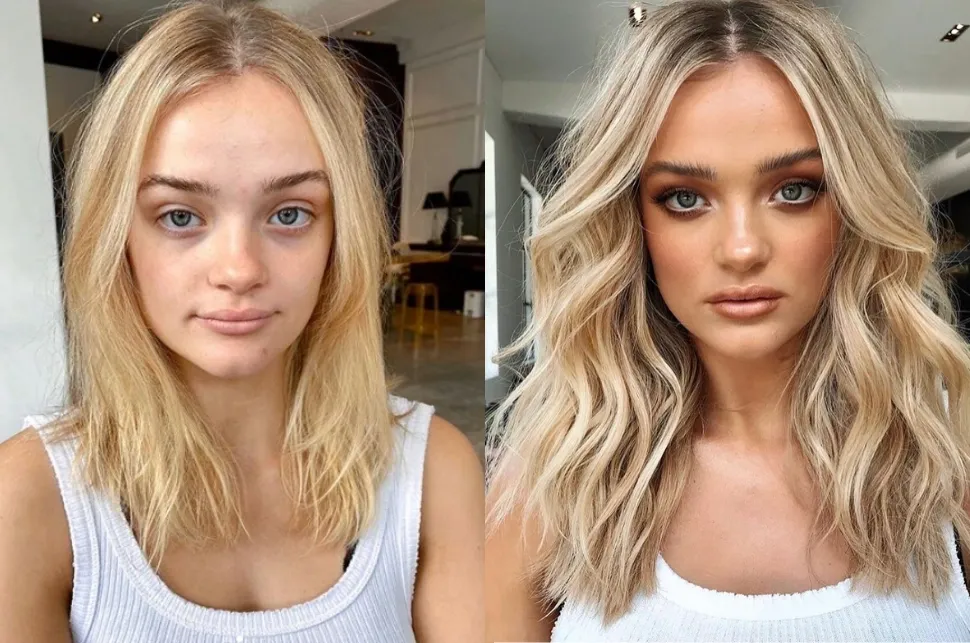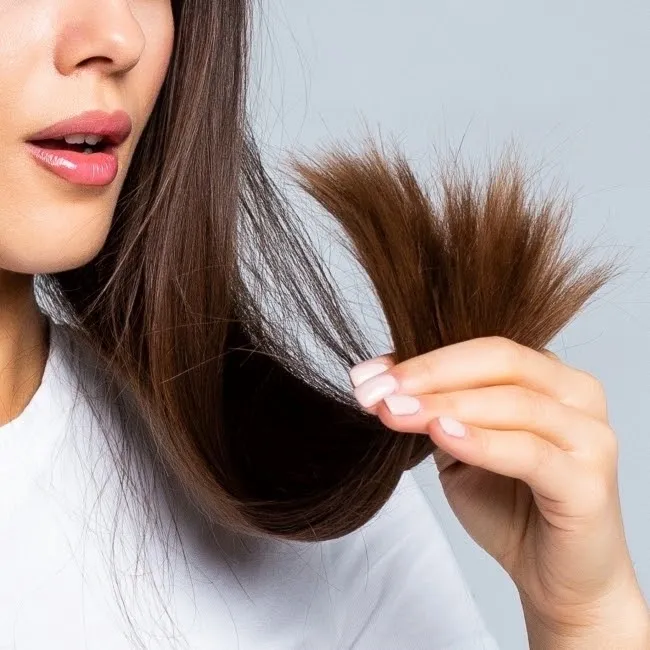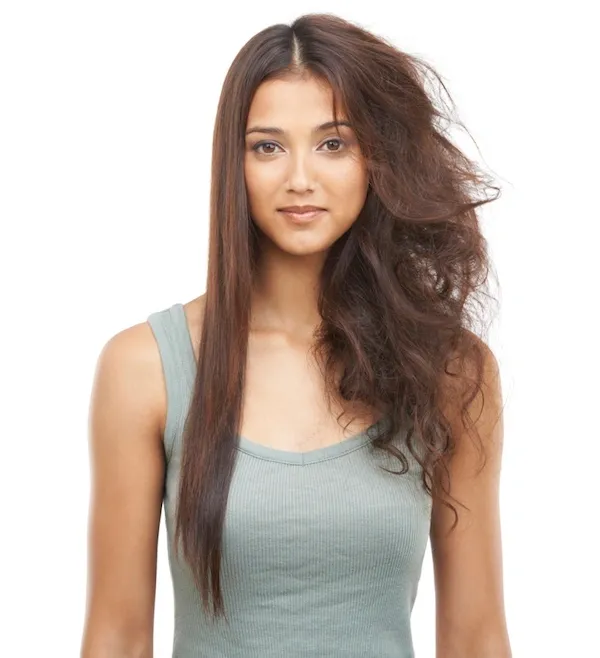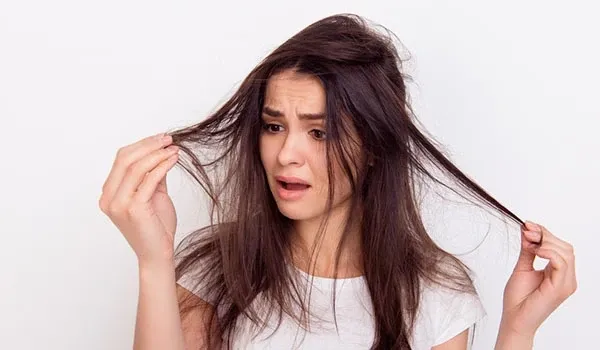Damaged hair can display itself in various ways, including but not limited to split ends, brittle-like texture, and excessive tangling. The fact of the matter is that these undesirable signs are an inevitable part of our daily routines. Whether you colour your hair, use hot tools, or tie it up every day, all of these behaviours take a toll on our strands. These unwanted signs of damage are our strands cry for help; to take care of our hair and get it back on the track to wellness, we need to treat damaged hair at the root of the problem. Damaged hair requires small, consistent adjustments, not a band-aid fix. Below we have listed our seven signs of hair damage and the remedies to get your hair back to a state of health.

1. Hair Loss or Thinning
There is the natural amount of hair we lose each day that resides in our brushes or naturally sheds as we wash. Then there are signs of shedding that serve as a warning sign.
Thinning around the hairline and throughout the head has multiple contributing factors. Thinning could be caused by stress, age, heavy medications, or that you have just had a baby. To prevent this type of hair loss it is vital that you maintain a clean scalp. You never want the pores on your scalp to get too clogged. To start, finding a good shampoo and conditioner can help alleviate this issue by removing daily buildup while delivering strength-building nutrients from roots to ends. We offer a range available to purchase in the salon, one of our most popular being Reken’s extreme strengthening shampoo and conditioner.
Hair loss could also be caused by a lack of protein, so a strengthening shampoo and conditioner are important and you could also consider a professional keratin treatment once a month to help strengthen the hair.
Finally, if you are on medications that may be affecting your hair loss and if you believe that might be the case, we would advise you consult with your doctor.

2. Split Ends
If your hair begins to fray, your ends are instantly dry when you get out of the shower, or there’s a thinning effect going on toward the perimeter of your strands, you likely have split ends. Regular trims can help eliminate the damage. Cutting the hair’s length will remove the damage and allow the hair to continue growing healthy and strong.
Split ends may also be caused by the weather or dryness, this leaves the hair in need of moisture. A hydrating oil used one to three times throughout the day will give the hair moisture and shine by deeply sealing and protecting the hair from heat, frizz, and UV damage. With regular haircuts and frequently added moisture, you’ll eliminate those split ends in no time.

3. Breakage
When you experience breakage, it’s likely due to a lack of elasticity meaning the hair is in a fragile state and cannot stretch much without breaking.
If you’re noticing breakage throughout your hair, you’re probably experiencing overprocessing from a colour service or a chemical treatment. Keeping your hair healthy and prepared for colour service is important. We recommend using a hair mask regularly to help the integrity of your hair. Deep conditioners and leave-in conditioners provide layers of protection and hydration for hair that is over-processed, dry or lacking strength and elasticity. These rich conditioning agents will not only detangle, they will protect your hair from UV rays, provide thermal protection from all your hot tools and seal the cuticle with the perfect balance of moisture and proteins.
To get your hair back to a state of health, hair needs a balance of protein and moisture, so keeping up by using products that are balanced with both keratin (the protein in hair) and moisture will help with the elasticity of the hair. Try using an intensive masque such as Redken’s moist repair which is available to purchase in the salon and is incredibly popular.

4. Dry, Dull Texture
Dry, brittle hair is usually caused by a lack of moisture and a lack of moisture comes from what you expose your hair to. Everything from the climate and water quality to the frequency of your highlights can affect your hair.
A good moisture routine, which can include infrequent shampoos and frequent conditioning, is a delicate balance of catering to your hair type and not stripping your hair of its natural oils. Using a moisturising shampoo and conditioner once a week can help with this issue.
When it comes to your lifestyle, pay attention to exposure. If you need to wash more frequently, try working a conditioning masque into your weekly routine. If you’re outside in harsh climates or travelling often, turn to a conditioning spray that offers UV protection. No matter what your hair type or routine, filtered shower head will ensure your water quality isn’t exposing your hair to harsh, unwanted minerals that dry your hair out without notice.

5. Frizz and Flyaways
Frizz is a frequent complaint about certain hair types, and it may be your hair’s cry for help. If you’re noticing flyaways throughout the day and your hair’s frizz makes it hard to cooperate or difficult to manage, you might be dealing with some damage.
When damage shows up as frizz or flyaways, this could be caused by dryness from weather, over-shampooing or shampooing the ends of your hair. The remedy for this is added hydration and proper haircare that preps the strands before any styling. Using a detangler spray, like the Redken One United Leave-In Conditioner (available in the salon) will add moisture and protection from the dryer. We also recommend applying a styling cream to your ends for that added hydration to tame the frizz and flyaways.

6. Patches of Short Hair
If you’ve ever done an all-ver bleach and tone, or any other severe dramatic change in colour to your hair, you may be familiar with this level of breakage. Experiencing excessive breakage that results in short hair patches is often caused by chemical damage. Chemical damage can usually be repaired by adding a protein regime.
But chemicals aren’t the only treatments at fault. Excessive heat styling and tight updos may also be to blame. If you’re experiencing heat damage from the daily use of hot tools, rely on a heat protectant and nourishing oil to counteract the damage. For damage caused by tight hairstyles, try loosening it up or moving the style around on the hair, so the tension is not always in the same spot. We also suggest hair ties that won’t pull or tug at the hair, like invisi-bobble that is available to purchase in the salon. In the picture we included you can see this girl is unfortunately dealing with alopecia as well as patches of short hair. If you recognise these similarities in your hair, we can offer a personal consultation to analyse what the cause could be and how we can treat the problem. We also suggest using our wig service if you are hoping to cover your hair loss.

7. Excessive Tangling
If you’re experiencing any of the signs listed above, chances are you’re also experiencing excessive tangling. When the hair is already damaged and lacking moisture, the outer layer of your hair shaft is raised rather than smooth and flat. Because of this, it is more prone to form knots with other strands.
Avoiding surfaces that cause excessive friction can only do favours for your hair, whether or not you’re already experiencing damage with your locks. Sleep on a silk pillowcase and use a microfibre towel post-wash to protect your hair from rubbing up against abrasive fabrics. The hair is also in its most vulnerable state while it is wet, so rather than brushing your hair after the shower, try brushing and detangling the hair before you wash and condition. Furthermore, when you are ready to wash, moisturising leave-in treatment is a good option for hair that is tangling.

